The first twice hero of the Soviet Union
30 May 1942 on the air for the last time sounded confident Safon: "The cover took over." At this moment, its Kittyhawk Р-40 was located above the convoy of the PQ-16 convoy, which was part of the newly-worn channel of the Kildinsky Reach. Security ships were busy fighting with aviation, on the outskirts of the convoy, there was also a fight. The long-range twin-engine fighters Pe-3 attacked the "Junkers" and fought off the impending Messerschmitts themselves.
“I took the cover on myself,” the voice of Boris Safonov sounded, and immediately there was a pause in the thundering air. The business card of this ace was well known to everyone. In the spring of 1942, this pilot was the most famous fighter in our country.
About him composed military legends. Yes, and how not to fold if the Soviet Information Bureau gave, for example, a message about a battle conducted by seven fighters led by Hero of the Soviet Union Boris Safonov with fifty-two enemy aircraft. At the same time, thirteen enemy vehicles were shot down, and not a single bomb fell on Murmansk. You must admit that there is a distinct taste of the legend here, although the Soviet Information Bureau could not be mistaken ...
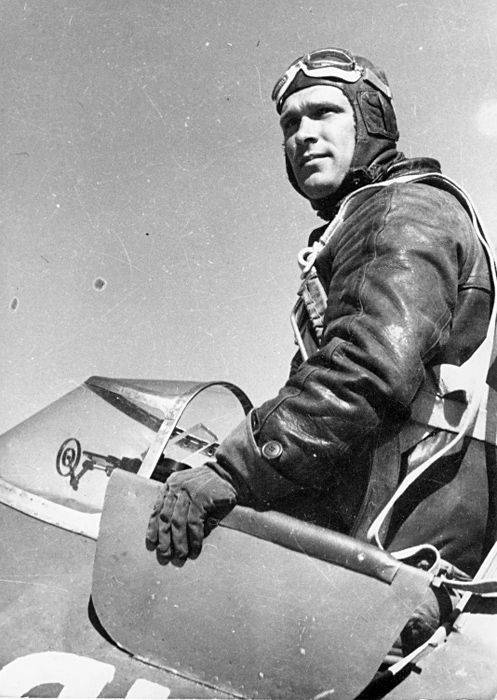
On the eve of the tragic day of 30 in May, the Safonov regiment was the name of the 2 Guards Red Banner on the frontline radio station Morozov, who was well acquainted with Safonov, and told him about the recent clash over the English convoy, in which two pairs of our fighters did not allow us to approach the transports one of the attacking bombers and torpedo bombers.
“Ours fought,” Safonov confirmed, and with a sigh, he added with a child's insult: “Now the command rarely lets me out in the air.” Only on holidays, you can say. " Indeed, at the age of twenty-six, he commanded a good aviation regiment, and they expected a lot from Hero of the Soviet Union Boris Feoktistovich Safonov (at that time he was already presented for awarding the second Gold Star). Of course, the command did the right thing, protecting the promising commander. However, the front is not a place where you can safely protect something or someone.
So, in the middle of the day in May 30 three “Kittyhawk” replaced the four long-range Pe-16 fighters in the sky over the PQ-3 convoy. But first you need to say why there were only three of them. Like everything else in war, this factor cannot be considered unimportant.
From his airfield, Boris Safonov raised two pairs of fighters. Major A. Kukharenko, captains P. Orlov and V. Pokrovsky flew with him. The group included the most experienced fighters with extensive flight practice. American fighters Р-40Е, with which the regiment was recently equipped, turned out to be machines with a difficult character. These machines had a really serious drawback: their motor could not withstand long work in the forced mode. And the fast and the furious, as you know, is the main mode of air combat, where in order to win, you need to be faster, more maneuverable, you have to squeeze the maximum possible from yourself and the car, and sometimes even a little more.
A few minutes after departure, the motor on the car Kukharenko began to give interruptions, and he was forced to return to the airfield. The group remained three together, and the familiar “master-slave” scheme was broken. Fighters were in a quandary. Especially since at that moment, when Safonov took cover, the biggest attack began - during the whole time of the convoy’s flight - a raid by the fascist aviation. About forty-five bombers, covered by twenty fighters, went on the attack.
Thousands of people followed the battle with the transports and escort ships, in which three fought against more than six dozen. We saw how, drawing thick black stripes in a cloudy sky, planes fell. In that battle, Orlov and Pokrovsky destroyed Junkers alone. Safonov - two. The raid was repelled. But the battle with the Messers continued. It was here at KP that they took Safonov’s radiogram: “I hit a third ... motor ...”
According to the code "motor" meant an emergency landing. But maybe Safonov wanted to say that the overheated motor of his Kittyhawk refused? May be. We will never know what this last word said by Safonov really meant. His fighter, losing altitude, was planning in the direction of the destroyer North fleet "Valerian Kuibyshev."
Without reaching the ship for three or four kilometers, he hit the water and sank instantly. By order of the Northern Fleet Commander, Vice-Admiral A. G. Golovko, the destroyer left the military escort warrant and began to circulate at the landing site of the aircraft. Fighters under the command of Majors S. Kiryanov and V. Pronchenko were raised into the air. But many hours of searching did not produce results.
Soldiers' legends stubbornly denied the fact of his death. A very long time, sailors and infantrymen, and sometimes pilots who fought in the North, said that they allegedly saw with their own eyes how a fighter appeared from somewhere during an air battle, on which a multitude of stars were drawn - the number of fascists shot down. It means that this machine could not belong to anyone except Safonov. Having entered the battle, the “hawk” immediately began to bring down enemy planes one by one, and only one pilot in the North could do that too! Legends are legends, but in the death of Boris Safonov there are still circumstances that have not been clarified to this day.
People who knew Safonov, remember first of all its naturalness, which instantly disposed to itself. They remember an open smile, although he did not smile so often. They recall his now familiar brown leather raglan with a fur collar. Everything he said and did, and most importantly, the way he flew, surprisingly went to him. It was calm, even power and unlimited reliability.
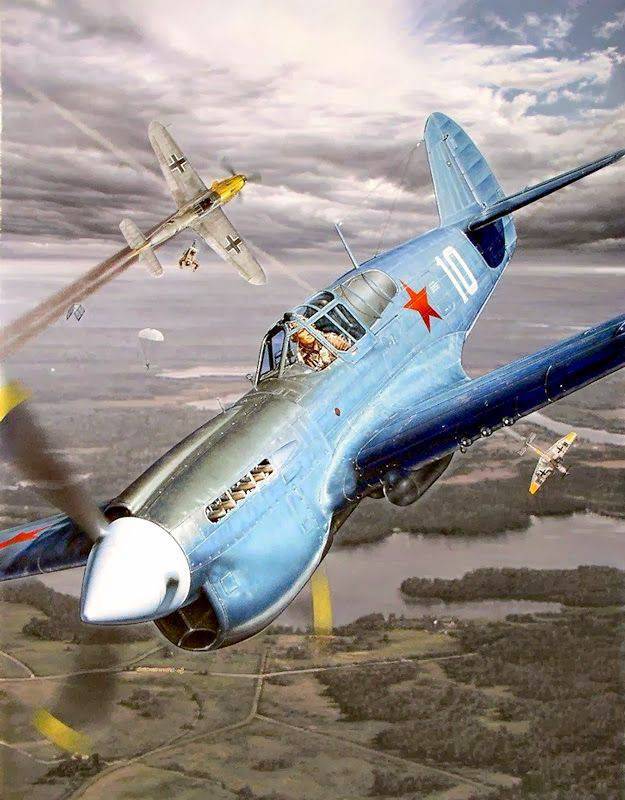
You can’t tell a lot about Boris Safonov’s past. Tiny particles of childhood and adolescence, which pop up in the memories of fellow villagers and relatives, are intertwined by distant islands in the whole ocean of uncertainty. We can only guess how his vocation was formed. But the desire to become a pilot has been visible since the age of sixteen, when he entered the Tula Glider School, and after graduating from it - at the Achinsk Flight School. Surely a significant role was played here by the winged call: “Komsomol member - by plane!”
“I studied well,” recalled Boris Thekla’s mother, Terentyevna, “I never had a concern about this, and I read very differently. I used to fall asleep, and he would block the lamp, so as not to interfere with me, and he would turn over the book. He also loved to listen to songs. I myself didn’t have a voice: I didn’t hear myself singing. He loved to listen. Our Senyavina, it is known, the village of songs. And in the summer, by twilight, they sing at all ends. ”
Here, perhaps, all that is known about the young years of Boris Safonov. Yes, the fact that a couple of times during his studies at the flight school, he came home. But here it did not stand out. He didn’t walk around the village and didn’t tell amazing aviators from the life of the aviators. Otherwise, be sure to remember. What can you imagine with such scant information? Is it that from childhood Boris Safonov had a definite goal and was preparing himself for the flight profession. That he was strong and brave, but did not try to subordinate peers. No one remembers, for example, that Boris was the horseman of the men of the Senyavin. And only one, briefly mentioned trait brings in this purposeful, but rather dry image a romantic and spiritual touch: love for the song.
From the North, Boris Safonov did not come home. The international situation was too complicated. Sharply felt the proximity of the war. Holidays northerners were not given.
22 Day June 1941 of the year divided life into two parts. War is monstrously cruel and unintelligible. A separate human life does not seem to exist for it at all: it counts on regiments and divisions. In such a war, where the front stretched from the Barents Sea to the Black Sea, the fate of entire armies was sometimes decided in a matter of days. And yet, for all its enormity, the war from the first moments calls its heroes. Calls by name: such as Captain Gastello. Or nameless: as the heroes of Brest and others who have overshadowed their homeland at the cost of their lives. The name of Senior Lieutenant Boris Safonov first sounded on the third day of the war.
In the evening of June 24 several He-111, jumping out of the hills at low altitude, attacked the ships in the bay. North Sea fighters climbed to the aid of the sailors. Boris Safonov chose Heinkel, which is detached from the general system. From a close range, he hit the radio operator, and the bomber's machine gun died off. From the second run in three bursts fired at point blank, Safonov literally chopped off the fascist's tail. The first Hitler's plane, shot down in an air battle by a North Sea pilot, crashed into the hills.
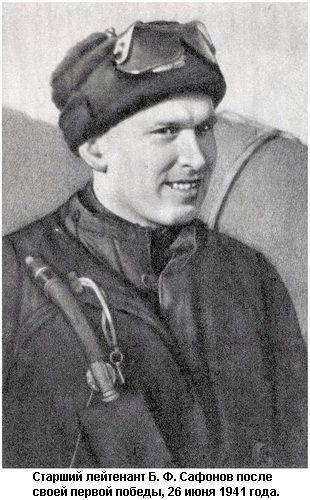
“Safonov is the hero of the day,” Rear Admiral A. Golovko wrote in the diary of the Northern Fleet Commander. - And, I think, not just one day ... He is a common favorite, this typical hare from under Tula. Excellent, strong-willed pilot. A broad-shouldered guy with an open face, a straight look dark gray eyes. One has only to see him, and he immediately evokes sympathy. Aircraft owned perfectly. According to aviation specialists, he has a very developed sense of time and distance. Leisurely, thorough - by the nature of this pilot with all the data of the commander. We must not lose sight of him, aim people to study with him. More to us such falcons. "
During these long clear days and white nights of the northern summer, Safonov is constantly at work. He leads a squadron, a link, flies in a pair, flies alone, when no one can stand it. He has an unquenchable thirst for revenge on the enemy. And she is amazing, combined with tranquility. The ability to make a decision in a fraction of a second was combined in it with the ability to calculate all possible options and choose the best one. Like the great chess players in time trouble. True, the price of defeats in battle is different than in the chess game. None of those who fought with him will remember that Safonov was confused. Even in the most incredible situation.
In the area of the Peninsula Rybachy group of fighters, led by the commander of the air regiment, Major Gubanov, took cover by bombers. The commander looked at his players and did not believe his eyes. When the group was escorted to the mission, there were five SATs in it. And six came back! Gubanov again counted the aircraft and then he saw the German air reconnaissance aircraft Hs-126, who had been attached to the formation. Apparently, the fascist hoped to fly with the group to the airfield and without a hitch to make aerial photography. The commander turned to attack, but he was ahead: Safonov pushed the scout into the hills with a powerful queue.
Another case. September 15 to the front line flew five fighters. Arrived in time: Junkers circled over our positions. Safonov and his followers V. Maksimovich and V. Pokrovsky attacked the fascists, and senior lieutenant A. Kovalenko with the knowledge of P. Semenenko started a battle with the fascist fighters of cover. In a matter of minutes, four Junkers were shot down, the rest retreated. Safonov could not chase them, as he noted that Kovalenko and his slave were in a difficult position. Safonov threw his group into the attack, the Nazis evaded direct combat, continuing to maneuver around our fighters, attacking from different directions. Then Safonov made a kind of decision. Knowing that the Messers had flown much earlier and their fuel was running out, he put his planes in a turn, and they started spinning around the carousel, covering each other. The Nazis tried to break the "carousel", attacking in a swoop, but as a result they lost one plane and, circling around the impregnable five, took a few more minutes to get off the back door. Safonovtsy returned to the airfield without casualties.
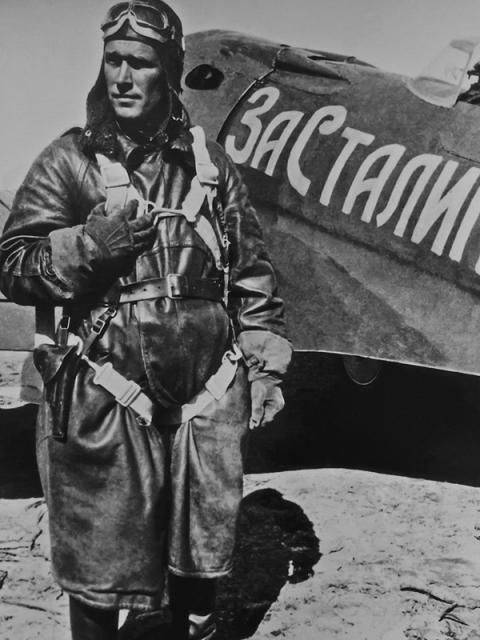
And here is how the fight was conducted, which the Soviet Information Bureau reported to the whole country: seven against fifty two! On a gloomy windy August day with almost ten-point cloudiness, the Nazis launched a powerful raid on Murmansk. The safon squadron was on duty in the air. Having explored the meteorological situation, Safonov found out that the lower cloud layer rises to almost four thousand meters, while the second layer begins one and a half kilometers higher. It is possible that the enemy will try to secretly approach the city precisely through a cloud-free “corridor”. Soon the bombers were discovered. But how to approach them? "Junkers" are surrounded on all sides by fighters Me-109, and the cover, as never before, is dense. Attacking head-on is pointless: the “Messers” will be tied up in battle, cut off from the bombers. Allowed seconds to think. Safonov's decision: ordered his fighters to go into the clouds and attack on their own. In this battle, individual skill, the training of each pilot of the Safon seven, was superbly displayed. Red star airplanes unexpectedly jumped out of the clouds from above and below, attacked and immediately disappeared in a thick veil. The Messerschmitts rushed helplessly around, but were powerless to prevent the fighters from killing heavily bombs Yu-88 one by one. The fascists were trapped. They did not dare to go into the clouds themselves, since they would immediately lose each other. To continue this flight was tantamount to suicide: the clouds seemed to be infested with Soviet fighters. The first could not stand the bombers. Without a team, they dropped their bombs at random and, diving into the clouds, lay down on the opposite course. A massive enemy air raid on Murmansk was repulsed, and the Safonovs, without losing a single car in combat, destroyed thirteen enemy aircraft.
In September, 1941 of the year, in order to strengthen the air cover of the convoys going to Murmansk and Arkhangelsk from the allies of England and the USA, a group of English pilots with Hawker "Hurricane" aircraft arrived in the North. The squadron had the code name "Benedict". On the day of their arrival, North Sea fighters visited the Allies. Major E. Miller, the commander of the English formation, met our pilots in the “Hurricane” parking. After the pilots were introduced to each other, Captain Safonov offered Miller to show his fighter. "Hurricane" - the machine is complicated. Only very experienced pilots are able to master it, ”said the major. But Safonov did not back down: “You show, and we will try to understand how difficult it is. Miller nodded and went to the parking lot. Everybody followed him in a crowd. Safonov sat in the cockpit in the pilot's seat. Standing on the wing, Major Miller, through a translator, explained the purpose of the instruments, the effect of the main units and controls. Safonov listened without interrupting. When the explanations ended, Safonov turned to the translator: “Tell the major, let him check how correctly I understood,” after which he imitated all the actions that the pilot had to take in order to lift the Hurricane into the air. The English major could not find a single error. Then he began captiously asking Safonov about the appointment of all instruments, arranged, in a word, the real exam on the material part of his plane and, finally, smiling, raised his hands: “Tell Mr. Safonov that he can fly out on the Hurricane right now” .
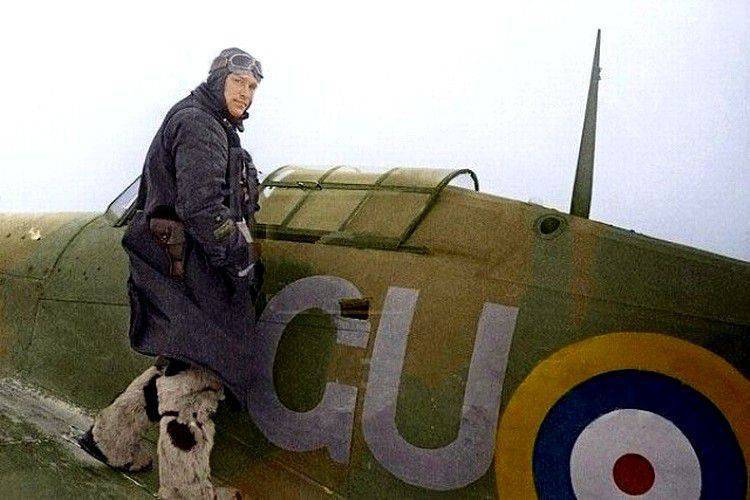
Later, in the course of joint actions, between the Soviet and British pilots began to develop in a front-line companionship. Here the closed and, what to hide, at first some arrogant British managed to appreciate the Soviet pilots, and above all their dedicated collective work in the air. It was for the British something completely new. More than once they could see how Soviet fighters risked their lives without hesitation in order to help out a comrade. About a month later, the British, without noticing it, began to do the same. Once they came to the aid of the Safonites very timely.
Once after the battle, Safonov conducted a debriefing with his group. Suddenly, nine Me-109s leaped out due to the near-lying hills. The pilots rushed to the machines, but many of them probably would not be destined to take off at that time, if the Hurricane pair were not around. The British instantly oriented themselves and attacked the fascists, diving to the airfield. And one of the British maneuvered so well that the first line hit the Messer. The attack was foiled, and the Nazis went into the clouds. The hero of that day was Sergeant C. Howe. In the evening, when Boris Safonov congratulated the sergeant on his victory, the young pilot was glowing with joy. Shaking hands with Safonov, he said the same phrase several times: “In England, the pilot who shot down five enemy vehicles was given the title of“ ace ”, and I am happy that I was congratulated on the victory by the Russian three times as much.”
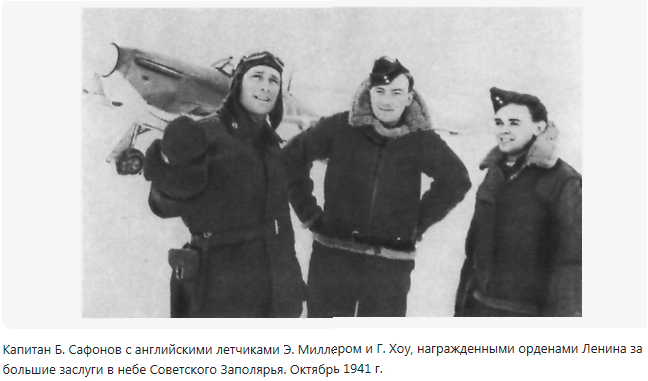
Safonov, no less than his flying talent, was endowed with another, much rarer human gift — he was the perfect leader. Under the leadership of such a leader, the team is able to perform miracles. In the safon squadron there was no special selection of pilots. Moreover, just before the beginning of the war many young guys came to him. But from the very first days of combat, Safon fighters fought best not only in the regiment, but also throughout the Northern Fleet. They also shot down more than others, and the losses were incomparably smaller. But that's not all. Pilots of the squadron no wonder called safonovtsami. All of them bore the visible imprint of the commander’s personality. And when they left the famous squadron and became commanders themselves, now, next to them, everyone began to feel like a strong and skilled fighter.
In October 1941, Safonov accepted the regiment. And immediately in all formations and even headquarters the regiment began to be called Safonov. How did this regiment fight? In the order of admiral N.G. Kuznetsov's assignment of the Guards rank to the regiment stated: “The 72 Red Banner Aviation Regiment for the 4,5 month of hostilities destroyed 118 enemy aircraft in air battles and destroyed 24 on airfields, destroyed as a result of assault actions more than 2000 destroyed enemy infantry X-NXX. and destroyed 3 coastal artillery batteries, repeatedly destroying moorings and facilities at enemy ports. ”This was the first guards air regiment in the Northern Fleet.
In the post-war years, articles appeared in a number of Western publications claiming that Safonov's Kittyhawk was shot down by a German pilot. Even some details were cited: as if, at the time when Safonov was fighting with a bomber, from below, invisible against the sea, he was attacked by a “Messerschmitt”, after which Safonov’s plane fell into the sea. This version has many vulnerabilities, and above all it seems strange that it appeared with all the details many years after the war. In addition, this version is not supported by documents, although there is a detailed chronicle of the entire period from 25 to 30 in May, when German aircraft conducted thirty large, but unsuccessful attacks on the PQ-16 convoy. The documents say that the famous Northern Fleet ace Lieutenant Colonel Safonov died in an air battle on 30 in May. If one could attribute the victory over the hero of the Polar region to any particular pilot, this would certainly have been done. Thus, the most reliable is the assumption that Safonov died as a result of engine failure - the "disease" characteristic of Kittyhawks during long-term afterburner operation.
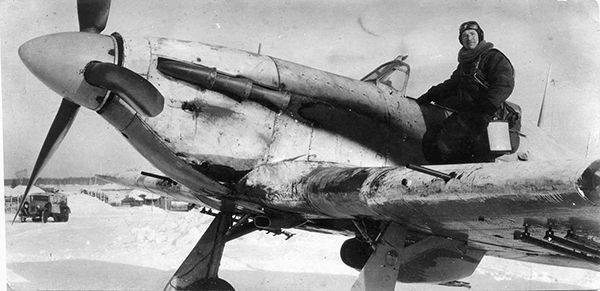
Boris Feoktistovich Safonov fought the entire 11 months, the departure for the cover of the convoy was his 224-m sortie. In it, he brought the score downed aircraft to 22, in the group battles, he destroyed another enemy machine 3. Such a combat account by the time there was no one fighter pilot in our country. 14 June 1942 published the Decree of the Presidium of the Supreme Soviet of the USSR on awarding Hero of the Soviet Union Lieutenant Colonel B.F. Safonov second medal "Gold Star".
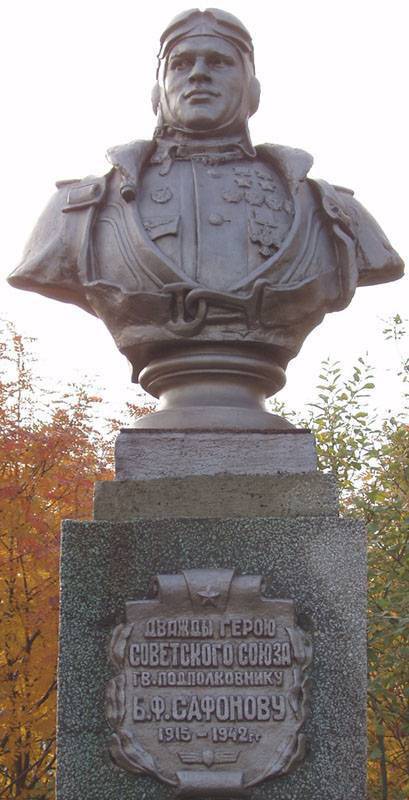
Sources:
Egers E. Soviet Aces. M .: Tornado, 1997. C. 20-22.
Kanevsky A. First among the North Sea // Aviapanorama. 2006. No.55. C. 18-20.
Rybin Y. About Safonov is not according to the memoirs // World Aviation. 1995. No.1. C. 12-17.
Citizen S. Greatest fighter aces // Aviation and Cosmonautics. 1995 No.11. C. 59-61.
Chechen V. Tsybulsky I. Wings over the ocean. M .: Young Guard. 1986. C. 54-63.
Babakov A. Heroes of the Soviet Union. Tom 2. M .: Voenizdat, 1987. C. 420.

Information